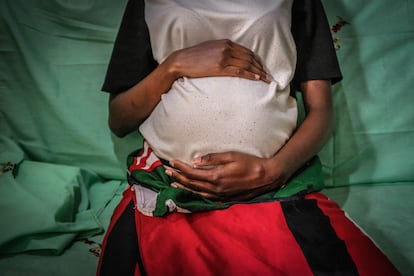Innovating to save lives: the challenge of postpartum hemorrhage worldwide

Strictly opinion pieces that reflect the author's own style. These opinion pieces must be based on verified data and be respectful of individuals, even if their actions are criticized. All opinion pieces by individuals outside the EL PAÍS editorial team will include, after the last line, a byline—no matter how well-known—indicating the author's position, title, political affiliation (if applicable), or main occupation, or any that is or was related to the topic addressed.

Every day, more than 700 women die from pregnancy- or childbirth-related causes . The leading cause is postpartum hemorrhage , which accounted for 27% of these maternal deaths in 2020. Despite its impact, this condition remains an invisible emergency on the global health agenda.
Postpartum hemorrhage affects between 1% and 10% of women who give birth. Although it is largely unpredictable, effective tools exist to prevent and treat it. Oxytocin, an essential injectable medication, has demonstrated high efficacy in managing this condition and has contributed to significantly reducing associated mortality in high-income countries.
Oxytocin is an affordable tool that is generally available in low- and middle-income countries. However, its use for the management of postpartum hemorrhage has not had the desired impact, failing to reduce these deaths to a similar extent as in high-income countries. What accounts for this difference?
Maternal deaths are considerably more frequent in regions where access to qualified health personnel is limited.
First, oxytocin requires a constant cold chain to maintain its effectiveness, something difficult to guarantee in settings with limited infrastructure. Furthermore, the only available formulation of this drug is injectable, making it essential to have trained personnel to administer it. In practice, this limits its use to healthcare facilities, which contributes to the fact that maternal deaths are considerably more frequent in regions where access to qualified healthcare personnel is limited.
Faced with the urgent need for a better approach to postpartum hemorrhage, the World Health Organization (WHO), together with other key stakeholders, developed a strategic plan ( A Roadmap to Combat Postpartum Hemorrhage 2023-2030 ) that highlights research as a priority. Despite being the leading cause of maternal mortality, they conclude, this condition has not received sufficient attention in terms of research and development.
Between 2000 and 2023, 29 treatments for postpartum hemorrhage were investigated or marketed. This is a small number compared to the 155 for preterm birth or the 103 for preeclampsia/eclampsia during the same period. This lack of innovation targeting the prevention or treatment of postpartum hemorrhage highlights the worrying lack of priority it receives in maternal health research.
Among the innovations that could replace injectable oxytocin are inhaled oxytocin and sublingual oxytocin. Both formulations allow for the elimination of the cold chain and are less demanding in terms of the need for a healthcare facility or trained personnel for administration. Although still in an early stage of development, these alternatives could improve access to oxytocin and reduce mortality and morbidity associated with postpartum hemorrhage in resource-limited regions with a high rate of maternal deaths.
Investing in the development of products aimed at the most vulnerable populations and ensuring effective implementation in these contexts is essential.
However, both formulations face several challenges. The main one is the limited interest of the pharmaceutical industry, which fails to find a significant market for these alternatives to injectable oxytocin in high-income countries. Furthermore, the low—and declining—fertility rates in these countries reduce the demand for treatments for childbirth complications. This means there is little pressure to invest in developing alternatives that could be more useful and reach more people in regions with higher fertility rates but limited resources.
Maternal mortality remains an urgent global health challenge, especially in resource-limited regions and in contexts of crisis or conflict. Although significant progress has been made—between 2000 and 2023, maternal mortality was reduced by 40%—the current figures remain alarming. Furthermore, enormous inequalities persist according to countries' standard of living and, more profoundly, according to the value each society places on women's lives and health. While maternal mortality in low-income countries is 346 deaths per 100,000 live births, in high-income countries this rate is just 10 deaths per 100,000. This is an unacceptable gap in terms of equity and social justice.
It is essential that clinical research promote innovative solutions for the prevention and treatment of the leading cause of maternal death: postpartum hemorrhage. It is also necessary that this problem be adequately addressed, with sufficient resources to achieve the desired impact: the reduction of preventable maternal deaths. Investing in the development of products targeted at the most vulnerable populations and ensuring effective implementation in these contexts is critical to generating real and lasting change. Without adequate investment, potential solutions will remain out of reach for those who need them most.
EL PAÍS





